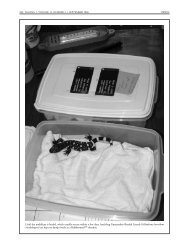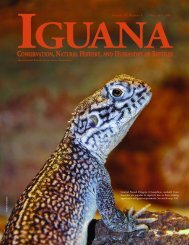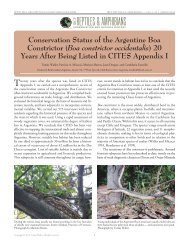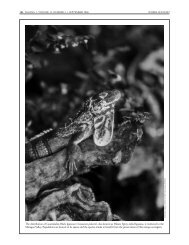Spiny-tailed Iguanas (Ctenosaura similis) in Venezuela
Spiny-tailed Iguanas (Ctenosaura similis) in Venezuela
Spiny-tailed Iguanas (Ctenosaura similis) in Venezuela
You also want an ePaper? Increase the reach of your titles
YUMPU automatically turns print PDFs into web optimized ePapers that Google loves.
GUATEMALAN BLACK IGUANA<br />
Literature cited<br />
Acevedo, M. 2006. Anfibios y reptiles de Guatemala: Una breve síntesis con<br />
bibliografía. In: E. Cano (ed.), Biodiversidad de Guatemala. Universidad<br />
del Valle de Guatemala.<br />
Álvarez del Toro, M. 1960. Los Reptiles de Chiapas. Instituto Zoológico del<br />
Estado Tuxtla Gutiérrez, Chiapas, México.<br />
Ariano-Sánchez, D. 2003. Distribución e historia natural del Escorpión,<br />
Heloderma horridum charlesbogerti Campbell y Vann<strong>in</strong>i, (Sauria:<br />
Helodermatidae) en Zacapa, Guatemala y caracterización de su veneno.<br />
Biology degree thesis, Universidad del Valle de Guatemala.<br />
Ariano-Sánchez, D. 2006. The Guatemalan Beaded Lizard: Endangered <strong>in</strong>habitant<br />
of a unique ecosystem. Iguana 13:178–183.<br />
Ariano-Sánchez, D. 2007. Distribución potencial, ámbitos de hogar y patrones<br />
de comportamiento del lagarto escorpión Heloderma horridum charlesbogerti<br />
(Sauria: Helodermatidae) con notas sobre el primer reporte de caso<br />
de envenenamiento por esta especie en Guatemala. Master of Science thesis,<br />
Universidad de Costa Rica.<br />
Ariano-Sánchez, D. and G. Salazar. 2007. Notes on the distribution of the<br />
endangered lizard, Heloderma horridum charlesbogerti, <strong>in</strong> the dry forests<br />
of eastern Guatemala: An application of multi-criteria evaluation to conservation.<br />
Iguana 14:152–158.<br />
B<strong>in</strong>ns, J. and F. Burton. 2007. Beads Tags. International Reptile Conservation<br />
Foundation and Blue Iguana Recovery Program, USA.<br />
Buckley, L. and R.W. Axtell. 1997. Evidence for the specific status of the<br />
Honduran lizards formerly referred to <strong>Ctenosaura</strong> palearis (Reptilia:<br />
Squamata: Iguanidae). Copeia 1997:138–150.<br />
Campbell, J. 1998. Amphibians and Reptiles of Northern Guatemala, Yucatán<br />
and Belize. University of Oklahoma Press, Norman.<br />
CONAP. 2008. Wildlife and CITES department database. Electronic data.<br />
Godínez, H. 2004. Poll<strong>in</strong>ation and seed dispersal by lizards: A review. Revista<br />
Chilena de Historia Natural 77:569–577.<br />
Köhler, G. 2003. Reptiles de Guatemala. Herpeton, Frankfurt.<br />
Köhler, G. 2004. <strong>Ctenosaura</strong> palearis. In: IUCN 2008. 2008 IUCN Red List of<br />
Threatened Species. .<br />
Krysko, K., F.W. K<strong>in</strong>g, K. Enge, and A. Reppas. 2000. Distribution of the<br />
<strong>in</strong>troduced Black <strong>Sp<strong>in</strong>y</strong>-<strong>tailed</strong> Iguana (<strong>Ctenosaura</strong> <strong>similis</strong>) <strong>in</strong> the southwestern<br />
coast of Florida. Biological Science 66:74–79.<br />
Lara-López, M.S. and A. Gonzáles. 2002. Alimentación de la iguana verde<br />
Iguana iguana (Squamata: Iguanidae) en La Mancha, Veracruz, México.<br />
Acta Zoológica Mexicana 85:139–152.<br />
Mills, S., M. Soule, and D. Doak. 1993. The keystone-species concept <strong>in</strong> ecology<br />
and conservation. Bioscience 43:219–225.<br />
Nájera, A. 2006. The conservation of thorn scrub and dry forest habitat <strong>in</strong> the<br />
Motagua Valley, Guatemala: Promot<strong>in</strong>g the protection of a unique ecoregion.<br />
Iguana 13:185–191.<br />
Olsen, J. and A. Valido. 2003. Lizards as poll<strong>in</strong>ators and seed dispersers: An<br />
island phenomenon. Ecology and Evolution 18:177–181.<br />
Pianka, E. 1966. Convexity, desert lizard, and spatial heterogeneity. Ecology<br />
47:1055–1059.<br />
Pianka, E. and H. Pianka. 1970. The ecology of Moloch horridus (Lacertilia:<br />
Agamidae) <strong>in</strong> Western Australia. Copeia 1970:90–103.<br />
Scott, N.J. and S. Limerick. 1983. Reptiles and Amphibians. In: D. Janzen<br />
(ed.), Costa Rican Natural History. The University of Chicago Press,<br />
Chicago, Ill<strong>in</strong>ois.<br />
Suazo, O.I. and J. Alvarado. 1994. Iguana negra: Notas sobre su historia natural.<br />
Universidad Michoacana de San Nicolás de Hidalgo, Ecotonica, A.C.<br />
IGUANA • VOLUME 15, NUMBER 3 • SEPTEMBER 2008 149<br />
Stejneger, L.C. 1899. Description of a new species of sp<strong>in</strong>e-<strong>tailed</strong> iguana from<br />
Guatemala. Proceed<strong>in</strong>gs of the United States Natural History Museum<br />
21:381–383.<br />
Traveset, A. 1990. <strong>Ctenosaura</strong> <strong>similis</strong> Gray (Iguanidae) as a seed disperser <strong>in</strong> a<br />
Central America deciduous forest. American Midland Naturalist<br />
123:402–404<br />
Traveset, A., and N. Riera. 2005. Disruption of a plant-lizard seed dispersal system<br />
and its ecological effects on a threatened endemic plant <strong>in</strong> the<br />
Balearic Island. Conservation Biology 19:421–431.<br />
Valenzuela, L.G. 1981. Contribución al conocimiento de la biología y ecología<br />
de <strong>Ctenosaura</strong> pect<strong>in</strong>ata e Iguana iguana (Reptilia: Iguanidae) en la costa<br />
de Jalisco. Degree thesis, Universidad Nacional Autónoma de México,<br />
México, D.F.<br />
Werner, D. 1987. Manejo de la iguana verde en el bosque tropical. Interciencia<br />
12:226–229.<br />
Guatemala supports a phenomenally diverse flora and fauna, which we<br />
will feature <strong>in</strong> an upcom<strong>in</strong>g issue. The Northern Tamandua<br />
(Tamandua mexicana) is a slow-mov<strong>in</strong>g anteater that <strong>in</strong>habits the dry<br />
and tropical forests of Guatemala. It feeds exclusively on ants and termites.<br />
The prehensile tail is well-adapted to a semi-arboreal lifestyle, as<br />
are the claws, which also are used for defense and tear<strong>in</strong>g open termite<br />
nests.








